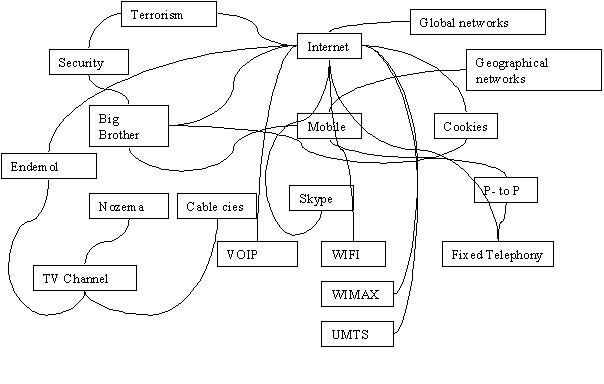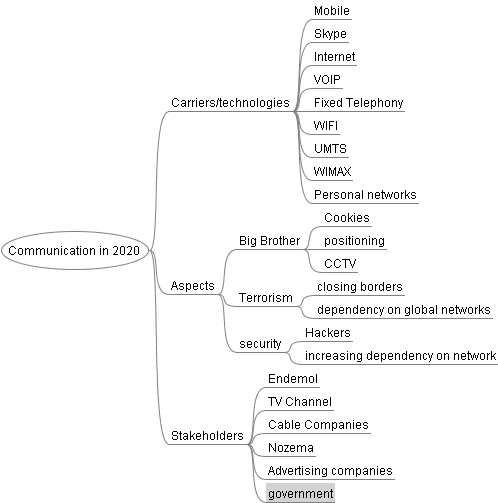The future of communication in 2015
Introduction
This page will contain the results of the scenario planning process of group 5 of class RSM EMBA05 on the following subject:
The future of communication in 2015
The idea behind this proposed scenario originates from the intensifying battle unfolding in The Netherlands between the incumbent telephony provider, KPN and the cable operator, UPC. Both companies enjoy a monopoly in their core product offerings – that is to say telephony, in the case of KPN and TV/Video, in the case of UPC – and were originally content to restrict their efforts solely to such offerings. Gradually, however, rapid technological advancements enabled both companies to compete across multiple products - TV/Video, the Internet and telephony (fixed and mobile). A recent development was UPC’s attack on KPN’s fixed line telephony business through VoIP (voice over IP). This was the first step in the rapid convergence of all technologies to the IP network. KPN have responded through an attack on UPC’s core product by investing heavily in TV/Video over the Internet (IPTV). How will the battle between the companies now develop?
The key to being able to answer this question is the drawing of a considered conclusion on how the communications industry – and in this we include the entertainment business also - will develop over the medium term – say the next 10 years.
Research questions
Research question - communication 2015
Driving Forces
Increasing Fear of a Terror Attack on internet
Increasing Fear of a Terror Attack on internet
Increase the connectivity between human and media
Increase the connectivity between human and media
Convergence of all media to IP network
Convergence of all media to IP network
Increase Governamental Control on the Internet
Governmental Control of the Internet
The Rapid Increase in WiFi Transmission Rates
The Rapid Increase in WiFi Transmission Rates
Improvement Voice-recognition system
=Technology=
- level of convergence of all technologies to the IP network (Jeroen)
- development of new technologies (Graham)
- security (RR)
- creation of unique identifiers and convergence of identifiers/numbers (Giuseppe)
- diffusion of Wireless (mobile) access (Wi-Fi/Wi-Max) to the Internet (Giuseppe)
=Strategy=
- Commoditization of technology and impact of low/no cost wireless connection (Erik)
- Appropriation of value (e.g. voip for skype)(Jeroen)
- Role of television channels: who will own the broadcasting (Graham)
- New role of advertisement (Giuseppe)
=Society=
- Influence of telecommunication on mobility, work habits, lifestyle and on interaction among individuals (Erik)
- Level of access to entertainment (Graham)
- Is technology the driver or is demand the driver (Jeroen)
- Privacy and separation of work from personal life (Rolando)
Research Documentation
Pause or Play? The Future of Interactive Services for TV Accenture white paper
Path to Profitability: How Cable Companies can Achieve Attractive Returns on iTV Servicesanother Accenture white paper
Freeband Communication is a Dutch national research program aiming to create a leading knowledge position for the Netherlands in the area of ambient, intelligent communication. Link to Freeband
Personal Networking Pilot 2008
link to: PNP 2008
Systems diagram
As a result of the first brainstorm the next concept system diagram is made:

The following "mindmap" is also a help c.q. a start to determine all the aspects related to communication in the future. Please send your comments and/or additions to the creator.
